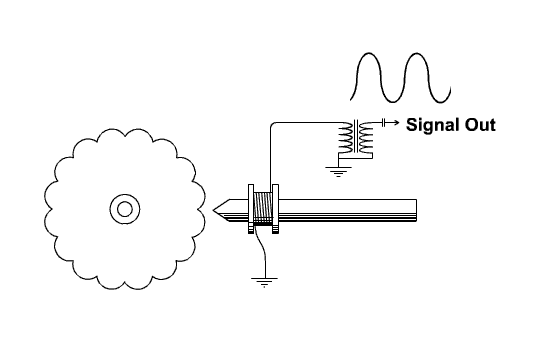The HAMMOND ORGAN
North Suburban HAMMOND ORGAN Service
In any electric or electronic musical instrument, the tones originate as a series of alternating current waveforms. Because the pitch range of traditional keyboard instruments usually covers a wide range of frequencies, the electronic substitute must likewise generate a considerable number of alternating currents, each having a different frequency. In these classic Hammonds, there are 91 tone generators that run all the time when the instrument is powered on and their resulting AC audio signals are present on normally open switch contacts under every playing key and pedal. Pushing any key or pedal connects the appropriate tone generator output(s) to the subsequent sections of the instrument for further processing, amplification and application to loudspeakers where the electrical signals become sound.
Figure 3, below. Typical Hammond tone wheel showing output signal and also the transformer and capacitor constituting a resonant filter.

Knowing this, we can look at the Hammond’s tone generating system, figure four, which produces the 91 different alternating currents. Each individual generator (figure three, typical) makes the frequency of just one note of the musical scale beginning with the lowest bass frequency of the instrument’s pedals (32.70 Hz.) and continuing up to the highest available frequency of 5924.6 Hz. Here, figure three, we show an animation of a typical tonewheel. In the animation, the wheel turns fairly slowly, and to the right, the moving sinewave represents the electrical output signal. In actuality, the tonewheels turn much faster, and would appear blurred like the blades of an electric fan.
Hammond’s unique tone generating system consists of a series of 91 toothed or lobed steel wheels, called tone wheels, each about two inches in diameter. The tone wheels for the lowest octave of generated tones have two lobes. Those for the second octave have four; for the third octave, eight; for the fourth, sixteen, and so on up to those for the highest complete octave of available frequencies which have 128. There are also seven additional tone wheels which have 192 lobes to generate the very highest available frequencies.
Figure four is an overall view of a complete Hammond tone generating system. The device contains the 91 different tone wheels, their associated permanent magnets and coils, the necessary gearing, bearings and lubrication system. It also has a shaded-pole induction motor to start the unit and get everything up to speed, a synchronous driving motor to turn the main drive shaft at exactly 1200 RPM, suitable LC resonant filters for the output signals, and a 16 pole rotary variable capacitor whose function I'll tell you about later.

Figure 4.Complete Hammond tone generating unit; including starting and running motors, resonant filter circuits, lubrication system and attached vibrato scanner on the synchronous motor.
If, for example, we want to produce the pitch A 440, this tone wheel (figure four) will have to make 1650 RPM, which will result in 440 teeth passing the tip of the magnet every second. Since a standard octave of a keyboard instrument includes twelve pitches, it follows that there must be twelve different rotational speeds for the various tone wheels. It is both the number of teeth and the rotational speed which determine the output frequencies.
One of the most important criteria for the instrument’s correct operation is for all of the tone wheels to spin at a constant speed. Although the various wheels run at twelve different speeds, each wheel must rotate exactly at its correct design RPM.To maintain this constant speed rotation, the entire series of tone wheels is driven from a central line shaft which is turned by a synchronous motor. A synchronous motor is one which runs in exact lock-step with the frequency of the AC power that supplies it. By its design, the Hammond tone generator synchronous motor makes exactly one revolution for every three cycles of incoming AC. On 60 Hz power, this is 1200 RPM.
Previous page Page 3. Next page